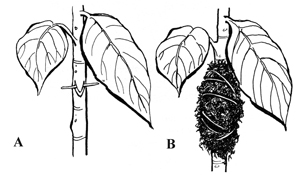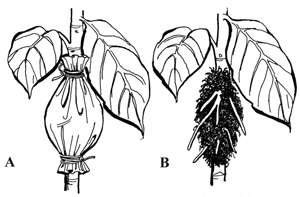G1853
Propagating House Plants
The process of propagating various house plants is described in this NebGuide, which includes a listing of common house plants and how-to methods of propagating.
David E. Lott, Extension Educator
Dale T. Lindgren, Professor Emeritus
- Cleanliness
- Potting and Propagation Medium
- Methods of Propagation
- Seeds
- Cuttings
- Types of Cuttings
- Division
- Runners
- Air Layering
- Acknowledgment
Propagating house plants in the home is an inexpensive and enjoyable hobby. Most house plants can be propagated at home satisfactorily with a minimum of special equipment. House plants may be propagated by seeds, cuttings (tip and stem, cane, whole leaf, leaf section, leaf bud), division, runners, and air layering. All of these methods are described in this publication.
Cleanliness
Before propagating plant material, start with clean and sterile containers, equipment, potting media, and plant material. Containers and tools need to be thoroughly washed and sterilized with a 10 percent bleach solution, and dried completely before being used. Potting media that is not known to be sterile needs to be heated thoroughly from 150° to 200°F for 20 to 30 minutes to sterilize. New potting media or individual sources of peat moss, vermiculite, and perlite do not need to be sterilized.
Only use cuttings from healthy plant material for propagation. Clean tools between removal of cuttings from different plants. Soilless potting media is recommended for propagation over field soil that can harbor diseases.
Potting and Propagation Medium
The most common materials used in plant propagation include potting medium, sand, peat, perlite, and vermiculite. Clean construction-grade sand can be used with equal amounts of peat moss for rooting cuttings. Vermiculite is a white-colored material that is used for plant rooting. It holds water well and helps keep plant cuttings from drying out during the beginning and continuation of growth of roots in the new plants. Perlite is another propagation material that is lightweight and provides good flow of oxygen to the root system. Soilless potting medium also can be used to root some propagated plant medium.
Methods of Propagation
House plants may be propagated asexually, in which all new plants will be identical, in most cases, to the parent plant; or sexually by seed, where the new plants will not necessarily be identical to the parent plants. Cuttings, air layering, division, and runners are asexual methods of propagation.
Seeds
Some plants such as cactus and African violets can be raised in the home from seed. Plants grown from seeds take longer to reach maturity. Variation among seedlings can make this method of propagation interesting.
There are many ways of germinating seed. Some are quite simple, while others are complex. All are intended to provide seeds with the proper moisture and temperature conditions. Germinating media useful for seeds include sand, sphagnum moss, peat moss, vermiculite, perlite, and a mixture of these media. The easiest method is to purchase commercial soil mixtures that are specifically for germinating seed.
For germinating seed, follow these steps:
- Place the germinating medium in a container with a drainage hole in the bottom.
- Moisten the medium by placing the container in a shallow pan of water. Remove when the top of the soil is moist.
- Spread seeds in rows over the surface of the medium.
- Cover seeds according to the directions on the packet. Small seeds like African violets or begonia should not be covered.
- Place the container in a polyethylene bag, and seal the ends with tape or Twist-Ems®.
- Set the container on a window sill in indirect sun, with temperatures of 65° to 75°F.
- Check the medium to maintain a damp condition.
- Remove the bag when the first seedling leaves are present. Provide the maximum amount of light required by seedlings.
- Transplant when the first true leaves develop.
Cuttings
Cuttings are severed parent parts that produce roots and/or stems to form a new and independent plant. Stems, leaves, or roots may be used. Equipment needed for rooting cuttings include a container, rooting medium, a sharp knife, a plastic bag, a source of plant material, and in some cases a rooting hormone. A rooting hormone is useful for encouraging rooting on difficult-to-root cuttings.
Care of Cuttings
Cuttings should never be allowed to dry out during the cutting, rooting, or establishment phase of new plant development. The exception would be for some succulents and cacti. Adequate humidity in and around the container holding the cuttings and new plants will help reduce the risk of plant material drying out. Humidifiers can be used to raise the humidity in the room where cuttings are being grown for individual plants.
For individual containers, insert stakes or a wire hoop in the container away from the cuttings. Slip a plastic bag over the stakes or wire hoops and securely fasten the plastic to the sides of the container. This cover will allow humidity to remain in and around the cuttings. Avoid placing these covered containers in direct sun as the heat will be absorbed, rapidly raising the temperature inside the plastic and damaging the cuttings.
Several methods of propagating plants by cuttings can be used. All are intended to provide the cuttings with proper moisture and temperature conditions, just as with germinating seeds. Cuttings can be rooted in water, sand, perlite, or vermiculite. Some plants are easy to root in water, but perlite or vermiculite generally gives more satisfactory results.
Select cuttings from healthy plants. When taking cuttings, make all cuts clean and at an angle through the stem, making sure there is at least one node (joint) under the surface of the medium. Mixing an equal part of perlite with peat moss creates a quality medium in which to root plants. Avoid using field soil as a potting medium. The lack of pore space in the soil particles reduces travel of water and oxygen through the medium. Field soil can also harbor disease pathogens that can threaten the health of plant cuttings and new plants.
Push the cuttings down in the medium about 1 inch. The medium should be moist but not soggy. Slip an airtight polyethylene bag over the cuttings and around the container. No further watering will be necessary. Place in a room at 60° to 70°F. Cuttings can be potted when they show an abundance of roots.
| Table I. List of common house plants and methods for propagating them. Some species (spp) may be propagated by more than one method. | |
| African Violet (Saintpaulia spp) | Seeds; whole leaf cuttings; division |
| Aloe (Aloe spp) | Division |
| Arrowhead (Syngonium spp) | Root cuttings that include a leaf node |
| Bloodleaf or Beefsteak Plant (Iresine spp) | Tip cuttings |
| Boston Fern (Nephrolepis exaltata bostoniensis) | Division; runners |
| Bromeliad (Many types) | Division |
| Cactus (Many types) | Seeds; whole leaf cuttings |
| Caladium (Caladium spp) | Division |
| Christmas Cactus (Zygocactus spp) | Tip cuttings |
| Croton (Codiaeum spp) | Seeds; tip cuttings; air layering |
| Devil’s Backbone (Pedilanthus tithymaloides variegatus) | Stem cuttings |
| Dracaena, Red-marginated (D. marginata) | Stem cuttings; air layering; cane cuttings |
| Dracaena, Masange’s (D. fragrans mauangeana) | Stem cuttings; air layering; cane cuttings |
| Dracaena, Ribbon (D. sanderiana) | Stem cuttings; air layering; cane cuttings |
| Dracaena, Gold Dust (D. godseffiana) | Stem cuttings; air layering; cane cuttings |
| Dumbcane (Dieffenbachia spp) | Tip cuttings; cane cuttings; air layering; division |
| English Ivy (Hedera helix) | Leaf bud cuttings |
| False Aralia (Dizygotheca spp) | Seeds; air layering; stem cuttings |
| Fiddleleaf Fig (Ficus lyrata) | Air layering |
| Fittonia (Fittonia spp) | Stem cuttings |
| Jade Plant (Crassula spp) | Tip cuttings; stem cuttings |
| Kalanchoe, Christmas (K. blossfeldiana) | Leaf cuttings; stem cuttings |
| Kalanchoe, Dwarf Purple (K. pumila) | Leaf cuttings; stem cuttings |
| Kalanchoe, Panda Plant (K. tomentosa) | Leaf cuttings; stem cuttings |
| Kalanchoe pinnata | Plantlets on leaves |
| Kalanchoe daigremontiana | Plantlets on leaves |
| Kalanchoe verticillata | Plantlets on leaves |
| Moses in the Cradle (Rhoea spp) | Division; seeds |
| Norfolk Island Pine (Araucaria spp) | Seeds |
| Passion Flower (Passiflora spp) | Seeds; stem cuttings |
| Peace Lily (Spathiphyllum wallisii) | Division |
| Peperomia (Peperomia spp) | Tip cuttings; whole leaf cuttings; leaf bud cuttings; division |
| Philodendron, Heartleaf (P. oxcardium) | Stem cuttings |
| Philodendron, Velour (P. andreanum) | Stem cuttings; air layering |
| Philodendron, Elephants Ear (P. domesticum) | Stem cuttings; air layering |
| Philodendron, Fiddleleaf (P. panduraeformae) | Stem cuttings; air layering |
| Philodendron, Splitleaf (P. pertusum) | Stem cuttings; air layering |
| Pilea (Pilea spp) | Stem cuttings; division |
| Poinsettia (Euphorbia pulcherrima) | Tip cuttings (allow wound to heal) |
| Prayer Plant (Marantha spp) | Division |
| Rubber Plant (Ficus elastica) | Air layering; seeds |
| Schefflera (Brassaia spp) | Seeds; cuttings of half ripened stems |
| Sentry Palm (Howeia spp) | Seeds |
| Snake Plant (Sansevieria spp) | Leaf section cuttings; division |
| Spider Plant (Chlorophytum spp) | Division; runners |
| Swedish Ivy (Plectranthus spp) | Stem cuttings |
| Umbrella Plant (Cyperus spp) | Seeds; division; upside down stem cuttings |
| Velvet Plant (Gynura spp) | Tip cuttings; stem cuttings |
Types of Cuttings
Tip and Stem Cuttings
Tip cuttings (taken from the tip of plants) are used to propagate common house plants such as the velvet plant and jade plant. Tip cuttings generally are 3 to 5 inches long and are removed from the parent plant at a point just below a leaf (Figure 1A).
Swedish ivy, pilea, and fittonia can be propagated by stem cuttings (sections of stems with leaves attached). The cuttings should have three or four leaves for best rooting.
Cane Cuttings
Cane cuttings are used for propagating dumbcane, Chinese evergreen, and similar plants that produce cane-like or leafless stems. Cut the cane into small pieces 2 to 3 inches long. Place the cuttings on their sides slightly below the surface of the rooting medium, such as perlite. A bud eventually will sprout and form a new stem when the cutting is rooted (Figure 1B).
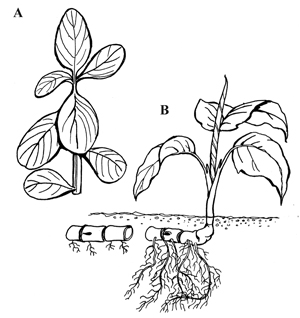 |
| Figure 1. Tip and stem cuttings (A), and cane cuttings (B). |
Whole Leaf Cuttings
Whole leaf cuttings are prepared from leaves with or without their stalks (called petioles). Roots and leaves eventually will form at the base of the leaf (Figure 2A). Peperomia and African violets commonly are started by whole leaf cuttings.
Leaf Section Cuttings
Leaf section cuttings can be used for propagating plants like the Rex begonia and snake plant. The leaves are cut into pieces, with the edge of the cuttings closest to the base of the parent plant inserted into the rooting medium (Figure 2B).
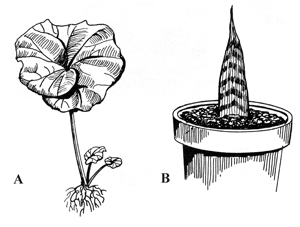 |
| Figure 2. Whole leaf cuttings (A) and leaf section cuttings (B). |
Leaf Bud Cuttings
Leaf bud cuttings consist of a single leaf attached to a piece of 1- to 1½-inch stem. The dormant bud, located where the leaf stalk joins the stem, will give rise to a new shoot and branches (Figure 3). The cutting should be inserted in the rooting medium with the bud about one-half inch below the surface. English ivy easily is propagated by this method.
Cuttings from succulents or cactus should be allowed to dry for one to seven days, depending on species and size, before placing in a rooting medium. The drying period will cause the cut edges to callous. This will prevent the absorption of excessive amounts of moisture that could result in rotting.
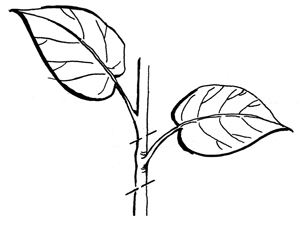 |
Figure 3. Leaf bud cuttings. |
Division
Division is the quickest way to propagate plants that produce stems at their base. To divide a plant, remove it from the container and separate the plant into smaller pieces with a knife or your fingers. Each division should have some roots. Divisions without roots may be rooted as tip cuttings. Plants can be divided at any time, although the dormant or rest period is best. Use division rather than leaf cuttings to propagate variegated plants, such as sansevieria. The non-variegated type is produced from leaf cuttings.
Runners
Runners, which are prostrate creeping shoots or stems such as found on strawberry geraniums, can be used to propagate some house plants. Place the leafy cluster of the runners in contact with a soilless potting medium in a second pot and hold them down with a paperclip or similar item (Figure 4). When roots have developed from the cluster, the new plant can be cut free from the runner. A simpler method would be to cut off the leafy clusters along with a small section of stem and root them as tip cuttings.
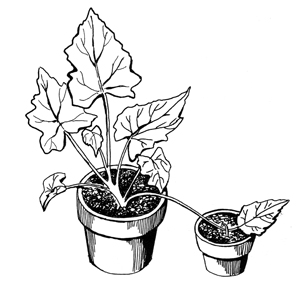 |
| Figure 4. Propagating plant runners. |
Air Layering
Air layering is a method extremely useful in shortening certain plants which become “leggy,” such as the rubber plant, Ficus elastica. With a sharp knife, make an upward or downward slanting cut 1- to 1½-inches long and about one-quarter to one-half way through the stem. Insert a matchstick or toothpick into the wound to prevent it from healing over, and dust a small amount of rooting hormone, if available, into the incision (Figure 5A). The rooting hormone usually hastens rooting if applied correctly, although some plants root just as well untreated. Remove leaves or twigs on the chosen stem about 3 to 4 inches above the incision point. Wrap the wound with two handfuls of moist, but not soggy, sphagnum moss to form a ball around the stem (Figure 5B). Wrap the moss with plastic film (example, a freezing bag) and seal the seam and edges with cellophane or electrical plastic waterproof tape or Twist-Ems to prevent water loss from the moss (Figure 6A).
|
|
After several weeks, roots should be visible near the edges of the moss ball under the plastic sheet. When a good root system has formed, remove the plastic film and sever the rooted tip from the stock plant at a point just below the ball of moss and roots (Figure 6B). Pot the rooted layer in the recommended soil mixture. The remaining portion of the cane can be saved and new buds will arise on it.
These are the most common methods of propagating house plants in the home. Many Internet sources are available detailing methods of propagation for specific house plants.
Acknowledgment
The authors would like to recognize contributions made by Don Steinegger, retired UNL horticulturist, to the first edition of this publication.
This publication has been peer reviewed.
Disclaimer Reference to commercial products or trade names is made with the understanding that no discrimination is intended of those not mentioned and no endorsement by University of Nebraska–Lincoln Extension is implied for those mentioned. |
Visit the University of Nebraska–Lincoln Extension Publications website for more publications.
Index: Lawn & Garden
Ornamentals
2008, Revised December 2012
